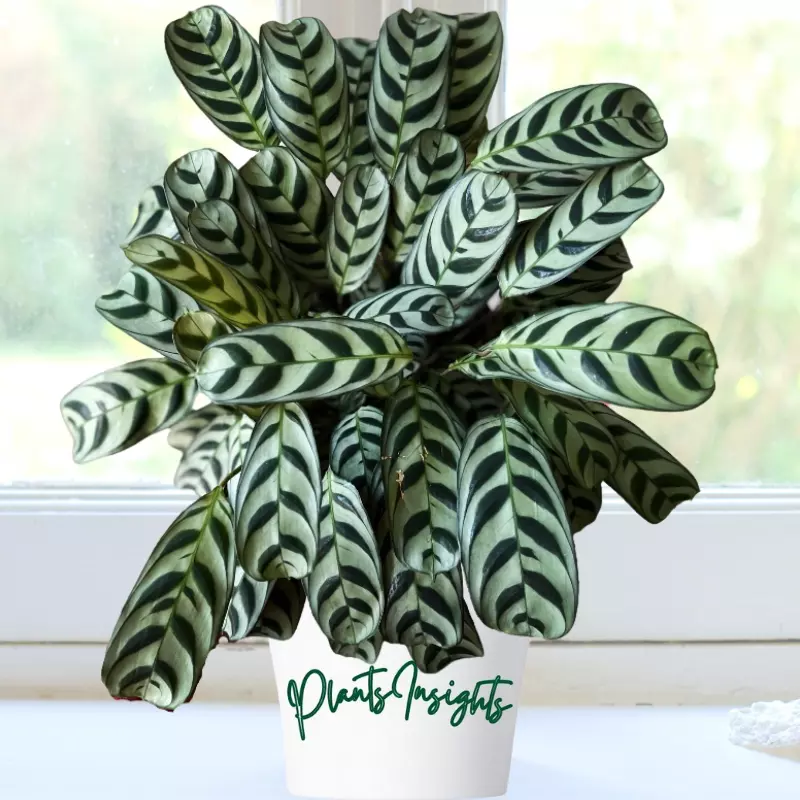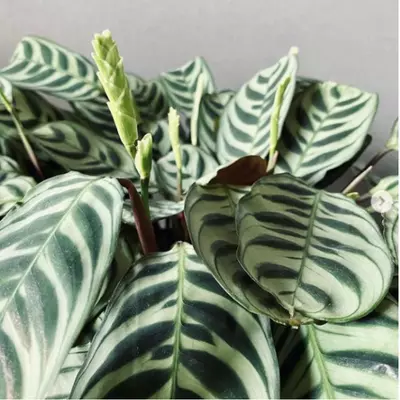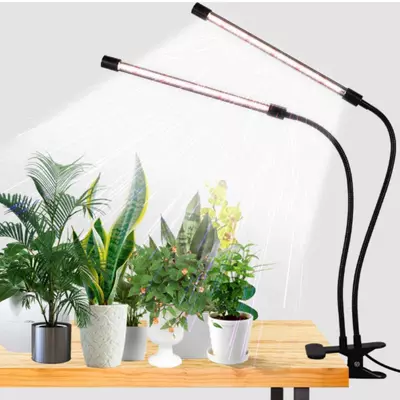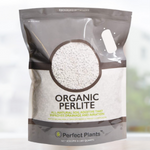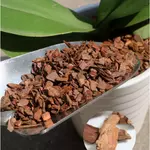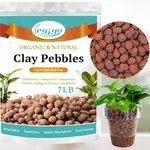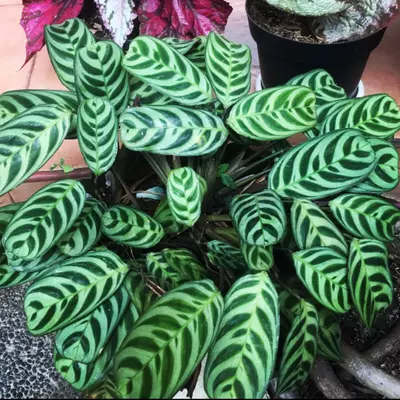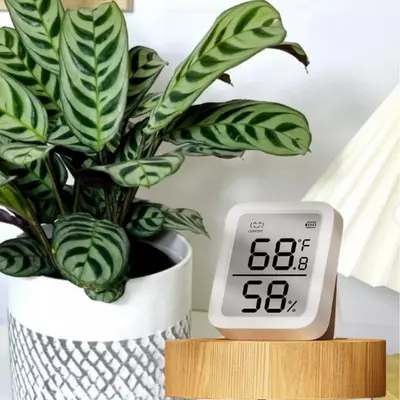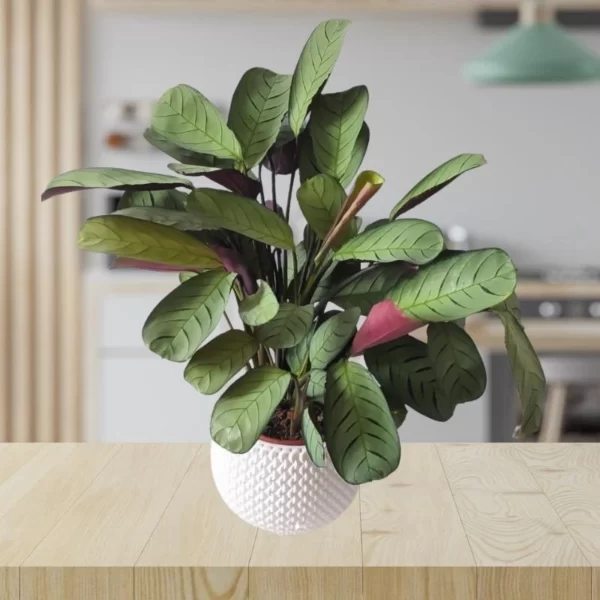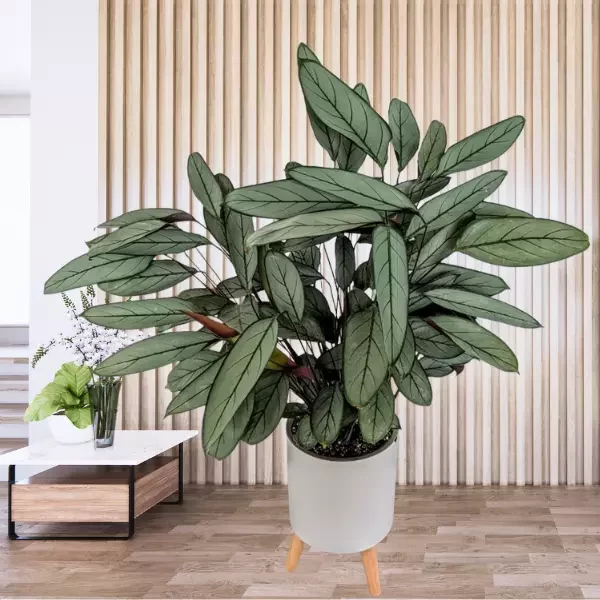The Ctenanthe Burle Marxii’s common name is The Fishbone Plant. This nickname is due to the interchanging patterns of dark green strokes that run along its midrib, which resembles the fish’s skeletal structure. The adorable foliage is oval in shape and light green in color. If the right conditions are met, the leaf pattern will be more vivid, and the underside will have a maroon or burgundy color. The plant is named after Roberto Burle, a Brazilian plant enthusiast who first cultivated the plant amongst his vast collection.
Like other members of the Marantaceae prayer plant family, the Fishbone plant also moves its leaves according to the light. There is some confusion about naming these varieties, as with many prayer-plants. Some have been reclassified, while others are mistakenly mixed with Calathea or Stromanthe plants. But the Fishbone plant is not a variety of Calathea or Stromanthe.
These plants are sold in shops under the names Maranta Amabilis, Calathea Amabilis, and Stromanthe Amabilis. Ctenanthe is a separate genus in the prayer plant family.
Allied Species: Ctenanthe Lubbersiana, Ctenanthe Burle-Marxii, Ctenanthe Setosa Grey Star, Ctenanthe oppenheimiana, Ctenanthe Setosa, Ctenanthe Marantifolia.
Habitat & Ecology
| Botanical Name: | Ctenanthe Burle-Marxii |
| Family Name: | Marantaceae |
| Common names: | Fishbone prayer plant, Ctenanthe Burle-Marxii Amabilis, Ctenanthe Amabilis, Never Never plant |
| Plant type: | Tropical perennial plant |
| Origin: | Rainforests of Brazil |
| Height: | 20 inches |
| Humidity: | (50%-80%) Medium to high humidity |
| Temperature: | 60-80°F |
| Light Requirements: | Bright, indirect light |
| Growth Habit: | Clumping, Upright |
| Toxicity: | Kids and pets safe |
How do you care of Ctenanthe Burle Marxii?
The Stromanthe or Never Never Plant likes partial shade or filtered light, continuous cozy temperature, and high moisture. They can tolerate all soil types, including clay, sand, and chalky, as well as all pH levels. The plant requires to be in a draft-free atmosphere.
It is optional that the plant is fertilized once a month, and it is not essential to prune the plant periodically throughout its development cycle. The plant must be repotted yearly, preferably in late spring to early summertime. It mostly takes 5-10 years for the Fishbone Prayer Plant to reach up to 20 inches, which is considered Its best height.

Bringing Ctenanthe Burle-Marxii plant Home
It is time to welcome your new plants into your home officially. It is important to quarantine any new plants and not throw a party. For at most 2 weeks, keep your newcomer from any other plants.
You should inspect your plant for disease and pests as soon as you bring it home. As your plant is being quarantined, keep checking it every few days. You don’t want viruses or pests spreading to other plants. Plant owners may also treat all new plants with insecticides to eliminate any hidden pests. It is entirely up to you.
Be aware that changing the environment can cause stress to your plant. It will take time for the plant to adapt to new surroundings. The new plant may not be lively as you would like in the first few days. Do not fright, and just give it some time to adjust.

What is the light requirement of the Ctenanthe Burle-Marxii plant?
If it doesn’t get enough sunlight, the beautiful pattern of the leaves will start to fade. Bright indirect light is the best for this Ctenanthe Burle-Marxii plant.
Too much intense light harms the Ctenanthe plants, like other prayer-plants. The leaves will become scorched by direct sunlight, and the soil will dry faster.
You should ensure that the sunlight is diffused if you plan to place your plant next to a window that receives strong afternoon sunlight. You can use curtains or blinds to soften the sunlight or place the pot two feet away from the window where direct rays can’t reach.
If you don’t have any bright spot in your house you might need grow lights to provide the required amount of light.

Water requirement for Ctenanthe Amabilis plant
If you know how to flourish the Calathea plant indoors by taking care of the watering schedule, then Ctenanthe Burle-Marxii is not a difficult task for you to radiate its beauty in your home.
Overwatering can cause death in members of the prayer plant family. These plants require constant moist media, so owners think to water them daily. Overwatering can lead to yellowing of the foliage and a limp appearance of the stem. However, underwatering can also cause yellowing of the leaves, eventually drying them up to the browning and crisping.
The roots of the Ctenanthe Burle-Marxii are fragile and thin, making them vulnerable to Root rot, the common root disease among the Marantaceae family plant members. We recommend giving your plant some water when the pot soil media is dry to the touch.
Don’t allow the whole pot soil mixture to dry. Your plant won’t like it and will let you know in the most detailed way by dropping or curling up the foliage. Using a moisture meter or soil aquameter may help determining the moisture of the soil.
Also, remember that the potting material also determines how and when to water the Ctenanthe Burle-Marxii plant. Plastic and ceramic pots are more likely to hold water longer than clay or terracotta pots with enough pores to let water out of the soil.
Ctenanthe Burle-Marxii is also known for being very picky about the water quality they drink. Chlorinated and hard water can cause damage to your Fishbone plant’s leaves. These will appear as dry, crispy edges or on the leaves. Crisping and browning of the leaves’ edges also occur due to low humidity. However, high-chlorinated water and water with high minerals will cause your plant’s leaf burns. Use filtered, rainwater, or distilled water.

Best soil composition for a potting mix
The correct mixture of pot soil is required to maintain a sufficient amount of moisture in the soil of your Fishbone Plant. The soil must have quick-draining quality and be able to keep enough moisture too, but not be soggy or waterlogged.
Most garden stores sell potting soils for tropical plants that meet the requirements of native land soil.
If you wish to make your own, use regular garden soil with perlite orchid bark to make it well-draining and moisture-containing for the plant. These soil combinations will help to aerate the soil, allow space for roots to develop, and facilitate water draining. Additionally, you can add peat or additional nutrients to the soil to retain the moisture. The right balance of these elements will ensure the happiness of your plant.
Recommended Products

Fishbone Plant Repotting:
Repotting is necessary to provide the extra space and supply of nutrients to your Fishbone prayer plant. This will allow the plant to enlarge and produce more leaves. The plan is to repot the plant every two years, as it will grow beyond its current pot.
When you report, choose the wide and shallow one instead of a large one. Since the roots aren’t that deep, the pot’s depth could create problems for the plant. A larger pot can also allow the Fishbone praying plant to grow horizontally.

Humidity and Temperature requirement for Fishbone Prayer Plant
Fishbone plants will not become dry and crispy if adequately watered and given high humidity. Even if everything seems in order, some leaf damage may still occur. This is how these plants work.
It is well-suited to live in high humidity areas because of its origins in Brazil’s rainforests. Besides the fact that rainforest floors are constantly moist, the plants’ humidity is maintained by the abundance of canopy transpiration.
Ctenanthe Amabilis flourish lively in high humidity up to 60 to 70%, but they can grow well in a 50% humid atmosphere, too. We recommend you don’t lower the humidity level below 50%. The plant may stand up to 40% but ultimately will show symptoms and signs of suffering.
You can imitate the natural environment of the rainforest by placing your plants near each other. Maintain high humidity indoors and protect plants from cold drafts. Also, a humidifier may be an option if your home is in a low humidity area. You can effortlessly meet the humidity requirements of your Fishbone plants by using a humidifier.
You can perform regular misting on each leaf with reasonable care. Misting can increase humidity for a brief period, but too much may cause water droplets that could lead to fungal disease.
Fishbone plants need warmer temperatures to thrive. It can be susceptible to frost and will die if left outside in the winter. It is slightly more resistant than other prayer-plants. It can tolerate temperatures down to 55°F/12°C but prefers higher temperatures.

Propagation for Fishbone Prayer Plant
The Ctenanthe Burle-Marxii plant grows in a fan-like pattern in a single cluster. It can develop horizontally in the pot or soil If it gets a favorable environment. Repotting is the ideal moment to determine whether to propagate the Fishbone prays plant or not.
Propagation of Ctenanthe plants takes place by division and is typically carried out during the growing season. Be sure to remove the roots from your plant to separate plants. Pick a cluster that has at least three to four leaves.

After the division, your plant will require time to settle. Don’t be concerned, even if your plant appears somewhat sad. Ensure you have the conditions described in this post to accelerate the setting process.
Avoid propagating and repotting during the winter months, as this could put you at risk of dying your plants because the conditions inside your home may not be ideal (lower temperature, humidity, and lighting).
To provide optimum growing conditions, you can set up the mini-ICU setup for your plants by covering them with a large amount of lightly misted plastic. This will provide the plant with greater humidity.

Fertilization of Ctenanthe Burle-Marxii
The Fishbone prayer plant doesn’t require a lot of fertilization. In fact, they can progress quite well without it.
When fertilizing your plants, make sure to water your plant before applying it. Over-use of fertilizer can cause an accumulation of salts in the soil. This can cause burnt tips on the leaves of the plant. Apply half of the fertilizer recommended dose for your plant in the growing season and not in winter. Based on the fertilizer you select, you can fertilize your plants monthly or every few months. Follow the directions on the product’s label to evade heavy dose.
If you use liquid fertilizers, be sure to fertilize your plants based on the moisture level to lessen the number of salts in the soil.
A general fertilizer for your houseplants will work well, and if you have an aquarium, you could also use aquarium water to boost extra nutrients in the potting soil of your plant.

How do you prune a fishbone prayer plant?
This Fishbone praying plant will be generous in growing the new leaves. Cutting off the old leaves of your plant will stimulate new growth of the healthy foliage.
Yet, pruning is not required unless you wish to limit the expansion of the plant. Cut back the overgrown leaves with clean and sterilized shears or sharp knives. Stems from the Fishbone plant are extremely leathery. This means you shouldn’t be able to cut the stem by yourself by breaking it, or you might unintentionally pull the plant out from the pot from its root. Therefore, always cut it with a sharp tool if you want to prune it.
To clean dust from leaves, use a soft, moist cloth. A mixture of dish soap and water (a drop in a massive amount of water) is also an option; however, we recommend testing the solution on a single leaf before cleaning the entire plant. Soaps contain various components that impact leaves’ health, and the Ctenanthe Burle-Marxii may not be a fan of each component.

Pests and diseases of the Fishbone prayer plant.
The plant is generally tough and resistant to pests and diseases; therefore, you shouldn’t face any problems with it.
When it comes to pests, spider mites are among the most common. Spider mites can easily be detected due to the webs present on the plant leaves and stem. Neem oil is the best insecticide that kills spider mites and protects the plant from further pest invasion too.
Fungal diseases are at the top of the list that your Fishbone prayer plant may have. This is more frequent than insect-related problems. The most fungal diseases your plant can be susceptible to are fungal root rot and leaf spot. Both are caused by the excessive moisture in the leaves as well as the roots.
The most frequent cause of leaf spots is misting and watering the plant leaves, mainly when it is done late at night. However, If too much moisture is trapped on the leaves or at the stems’ base, they form soft spots, which turn yellow and brown, killing all the leaves.
Leaf spots are challenging to treat, and fungal pathogens can spread when misting is done on an infected leaf. It can result in the transfer of spores from one plant to other leaves. Be careful to separate the affected Fishbone prayer plant from the other indoor plants. Immediately move it to an isolated spot while you are treating the disease.
Get rid of the infected leaves by pruning if the infection is severe and treat the entire plant using the recommended fungicide. Ensure that you cover every corner of the infected plant, including the bottom of the leaves and stems. Other fungal diseases that could be present are botrytis and powdery mildew that looks like white Ash on the top of plants, causing yellowing and eventually turning brown later.

Is Ctenanthe Burle-Marxii Amabilis plant Toxic?
Prayer plants are non-toxic for cats, humans as well as dogs. (ASPCA has listed Ctenanthe Burle-Marxii Amabilis as non-toxic). However, be aware that the consumption of any plant in large quantities, even though it is not toxic, may cause issues.
There have not been any adverse health problems relating to Ctenanthe Burle-Marxii Amabilis. Be aware that the information about the toxicity of plants may change. However, even with non-toxic plant species, keeping the plants away from pets is the best option, especially if they are inclined to eat them.
FAQs
How does Ctenanthe Burle Marxii grow?
Ctenanthe Burle Marxii grows in a warm and humid environment with an abundance of water and indirect sunlight. The plant is of spreading type and expands almost equally as it takes height.
How big do Fishbone prayer plants get?
The Fishbone Prayer plant does not grow tall and reaches up to a maximum height of 20in along with a width of up to 16in.
Related Posts
Ctenanthe Setosa Compact Star | Never Never Plant Care Tips
Ctenanthe Setosa Compact star has many trade names such as Calathea Setosa, Never-Never plant or Prayer Plant.
Ctenanthe Burle Marxii Amagris | Never Never Plant Care
Ctenanthe (pronounced te-NANTH-ee) Setosa ‘Grey Star’ of the Marantaceae family is an attractive and vibrant plant.
Ctenanthe Setosa ‘Grey Star’ Care and Propagation Guide
Ctenanthe (pronounced te-NANTH-ee) Setosa ‘Grey Star’ of the Marantaceae family is an attractive and vibrant plant.
Ctenanthe Oppenheimiana | Giant Bamburanta Care Guide
Ctenanthe Oppenheimiana | Giant Bamburanta (Never Never Plant) is a bushy perennial plant found in tropical forests in Northeast Brazil.
Ctenanthe Lubbersiana ‘Bamburanta’ Care Guide
Ctenanthe Lubbersiana, a member of the Marantaceae family, is renowned for its beautiful ovate foliage.Like other prayer plants, the long attractive leaves fold up at night.

